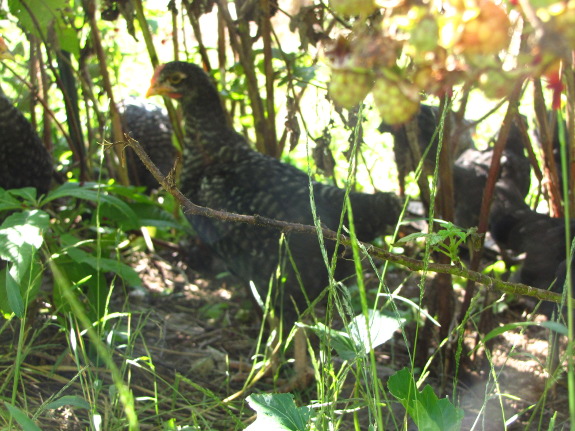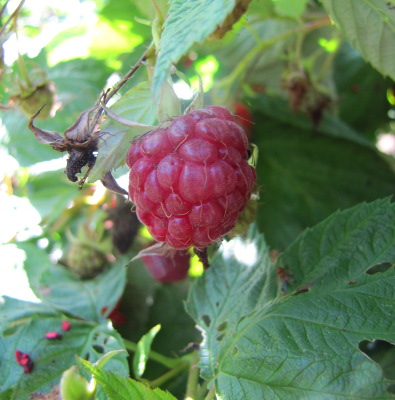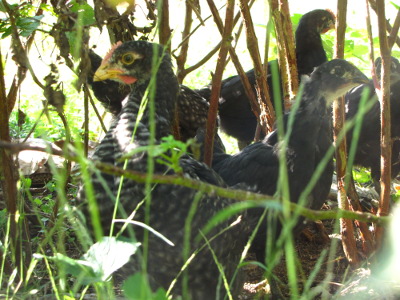
Permaculture stacking

 I've written about succession
planting previously, which involves keeping the garden active by
growing more than one crop per year in the same spot. But I
realized I'd never written here about a related permaculture principle
which is one of my favorites --- stacking.
I've written about succession
planting previously, which involves keeping the garden active by
growing more than one crop per year in the same spot. But I
realized I'd never written here about a related permaculture principle
which is one of my favorites --- stacking.
When permies use the
term "stacking", they are growing more than one crop in the same space
at the same time. For example, silvopastures
can allow you to raise timber (or nuts and fruits) right on top of
livestock while forest
gardens may stack
shade-tolerant herbs and leafy greens under fruit trees.
The best way to keep competition down when stacking is to
involve multiple kingdoms. For example, mushroom
rafts under a peach
tree don't compete at all --- if anything, the fungi slowly break down
the wood into high quality humus that the peach will enjoy while the
peach maintains a damp, shady environment for the mushrooms.
Even though they're in the same kingdom, putting
my bee hive in the chicken pasture this year has been a win-win.
 My favorite stacking success
has been letting our chicks free range throughout the raspberries (and
back garden) during their first month or two of life. The only
slight downside is that the chicks scratch the mulch to pieces, but
they find lots of invertebrates (and clean up any dropped berries) in
the process, all while laying down a thin coating of fertilizer.
The chicks feel safe because they're nestled amid thorny branches, and
that patch of raspberries seems to bear berries twice as large and
juicy as those on the other end of the homestead.
My favorite stacking success
has been letting our chicks free range throughout the raspberries (and
back garden) during their first month or two of life. The only
slight downside is that the chicks scratch the mulch to pieces, but
they find lots of invertebrates (and clean up any dropped berries) in
the process, all while laying down a thin coating of fertilizer.
The chicks feel safe because they're nestled amid thorny branches, and
that patch of raspberries seems to bear berries twice as large and
juicy as those on the other end of the homestead.
What's your favorite
example of stacking on your own farm?
Want more in-depth information? Browse through our books.
Or explore more posts by date or by subject.
About us: Anna Hess and Mark Hamilton spent over a decade living self-sufficiently in the mountains of Virginia before moving north to start over from scratch in the foothills of Ohio. They've experimented with permaculture, no-till gardening, trailersteading, home-based microbusinesses and much more, writing about their adventures in both blogs and books.
Want to be notified when new comments are posted on this page? Click on the RSS button after you add a comment to subscribe to the comment feed, or simply check the box beside "email replies to me" while writing your comment.

Great post. I am hoping to do the same thing when I get the bees next spring- place the hive in the pasture with the chickens. ( though not sure our little clearing in the pines is worthy of being called a pasture). I am also hoping to plant some more fruit trees in the other smaller smaller chicken pasture. They do tend to really destroy the mulch which in our dry climate is essential to the health of the tree, but I've found that if I layer newer dry pine needles over existing mulch, they are less likely to disturb it. Pine needles can be sharp! Comfrey and clover are planted under the trees as well. Everything is an experimentand it's all sort of mind boggling to me most of the time...- I live at 8200 feet elevation in a semi- arid ponderosa forest with volcanic pumice instead of dirt! It is by far the most challenging gardening climate I have ever experienced. Zone 5 doesn't even fully describe it ( and we have pockets of zone 4 too) because we can regularly have 50 degree temperature fluctuations between night and afternoon temps, even in July. I know Appalachia is far removed from these challenges, but perhaps one of your readers is a more experienced mountain gardener and might have wisdom to share. I'm looking up every book possible. I do sort of drool over all the green in your photos though....:-)
This fall I plan to move my 6 adult chickens into a fence berry patch. It is 30' x 40'. I have a few each of blueberrys, currents, rasberrys and strawberrys.
Should I leave these plants for the chickens to scratch around or remove all of them. I had hoped to leave them and put down netting to minimize the damage.
I would really like to work my chickens more into the garden areas.
Mona --- I'd definitely leave all the berry bushes. If they're well established, your chickens might coexist with them pretty well. If you have enough mulch, you might try to fill the whole space up with mulch, even within the aisles, because the chickens are likely to cause problems by kicking mulch away from the plants.
The only thing that probably won't make it is the strawberries. Maybe you could fence that part out?